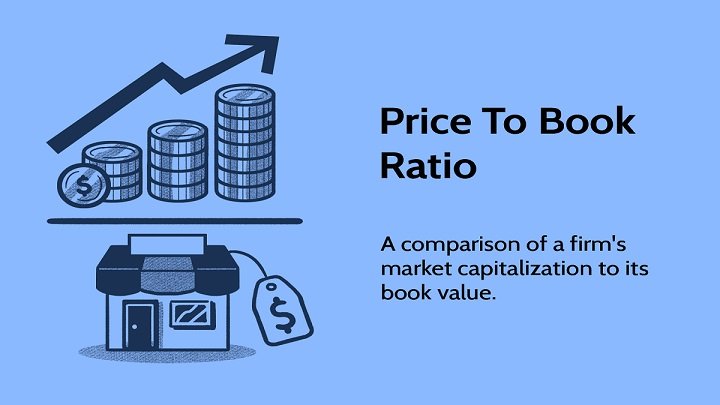Introduction to Book Value in Stock Market
Investing in the stock market requires a thorough understanding of various metrics that help assess a company’s financial health. Among these, book value holds a significant place. This article explores the concept of book value, a fundamental metric used to determine a company’s intrinsic value. It delves deep into how book value is calculated and its significance in the stock market.
What is Book Value?
Book value represents the net asset value (NAV) of a company as recorded in its financial statements. It is the total value of all assets a company owns, minus its liabilities. Shareholders would theoretically receive this amount if the company were liquidated.
Formula for Book Value:
Book Value=Total Assets−Total Liabilities\text{Book Value} = \text{Total Assets} – \text{Total Liabilities}
For example, if a company has $1 million in assets and $400,000 in liabilities, its book value would be $600,000.
Importance of Book Value in Stock Market
Understanding the book value is crucial for investors, particularly those using value investing strategies. Here’s why:
- Evaluating Stock Price: Comparing a stock’s market price with its book value helps assess whether the stock is overvalued or undervalued.
- Financial Health Indicator: A high book value indicates a strong financial position.
- Risk Assessment: Companies with a stable book value provide more security to investors during economic downturns.
- Basis for Value Investing: Investors like Warren Buffett often look for stocks trading below their book value.
Book Value Per Share (BVPS)
Book value per share (BVPS) is a key metric that translates the book value into a per-share figure. It is calculated as:
BVPS=Book ValueTotal Number of Outstanding Shares\text{BVPS} = \frac{\text{Book Value}}{\text{Total Number of Outstanding Shares}}
Example Calculation:
Suppose a company has a book value of $1 million and 50,000 outstanding shares. The BVPS would be:
\text{BVPS} = \frac{1,000,000}{50,000} = $20
Why BVPS Matters:
- Stock Comparison: Helps compare companies within the same industry.
- Investor Insight: Indicates the intrinsic value of each share.
Market Value vs. Book Value
A stock’s market value is the price investors are willing to pay for it in the market. Comparing market value with book value reveals important insights:
| Aspect | Market Value | Book Value |
|---|---|---|
| Definition | Price determined by stock market trading. | Value derived from balance sheet data. |
| Volatility | Highly volatile, influenced by market trends. | Relatively stable over time. |
| Usefulness | Reflects investor sentiment. | Shows company’s financial stability. |
Book Value and Price-to-Book (P/B) Ratio
A common valuation metric, the P/B ratio, compares a stock’s market price to its book value.
P/B Ratio=Market Price Per ShareBook Value Per Share (BVPS)\text{P/B Ratio} = \frac{\text{Market Price Per Share}}{\text{Book Value Per Share (BVPS)}}
Interpreting the P/B Ratio:
- P/B < 1: Stock may be undervalued.
- P/B = 1: Stock is fairly valued.
- P/B > 1: Stock may be overvalued.
Example Calculation:
If a stock’s market price is $30 and its BVPS is $20:
P/B Ratio=3020=1.5\text{P/B Ratio} = \frac{30}{20} = 1.5

Limitations of Book Value
While book value is a useful metric, it has limitations:
- Excludes Intangible Assets: Book value doesn’t account for assets like brand value or patents.
- Historical Data Bias: Based on historical cost, not current market conditions.
- Industry Variations: Not equally relevant for asset-light industries like technology.
How to Use Book Value in Investment Decisions
Investors can leverage book value in multiple ways:
- Identify Undervalued Stocks: Look for stocks trading below their book value.
- Risk Management: Focus on companies with a stable or increasing book value.
- Long-Term Analysis: Track changes in book value over time to gauge growth.
Real-World Examples
Case Study: Apple Inc.
In 2023, Apple reported:
- Total Assets: $380 billion
- Total Liabilities: $270 billion
Book Value = $380B – $270B = $110B
With 16 billion shares outstanding, Apple’s BVPS was:
\text{BVPS} = \frac{110B}{16B} = $6.88
Comparative Analysis Table
| Company | Book Value | Market Value | P/B Ratio |
|---|---|---|---|
| Apple | $110B | $2.7T | 24.55 |
| Microsoft | $250B | $2.5T | 10.00 |
| Tesla | $70B | $800B | 11.43 |
How Book Value Affects Stock Prices
Although book value alone doesn’t dictate stock prices, it serves as a benchmark for valuation. For example:
- A declining book value may trigger a sell-off.
- A rising book value might attract investors seeking stability.
Conclusion
Book value is a cornerstone metric in the stock market, providing insights into a company’s financial strength and intrinsic value. While it has its limitations, combining it with other metrics like the P/B ratio offers a well-rounded perspective for making informed investment decisions.
